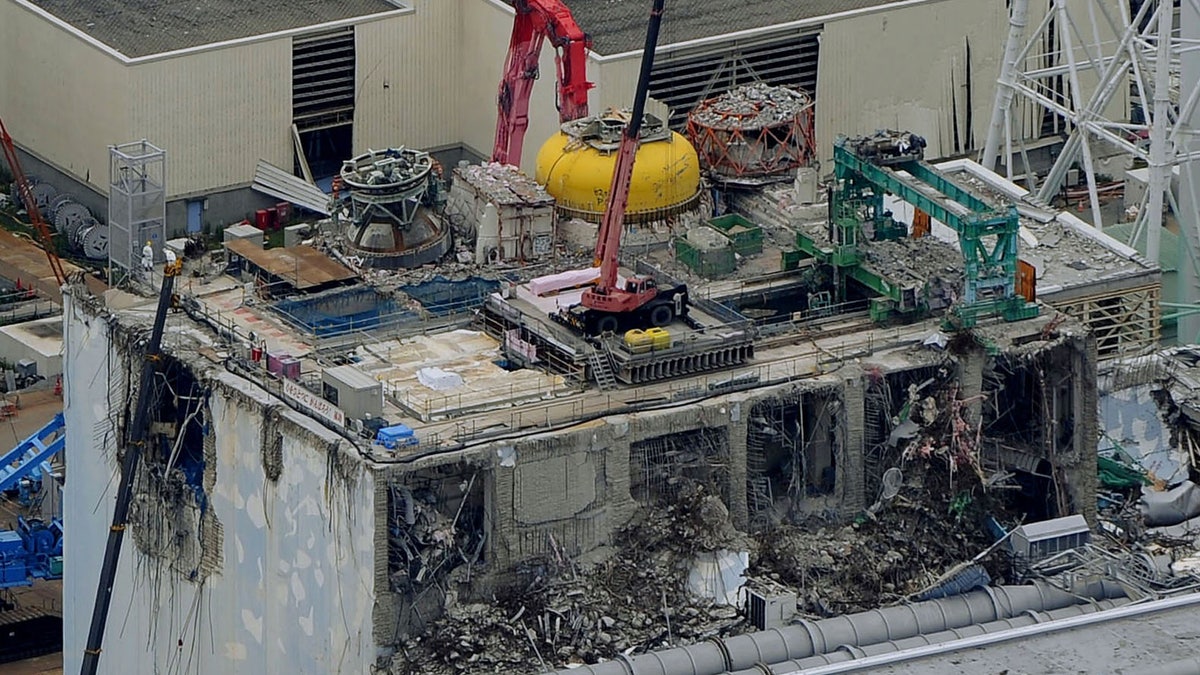
July 18, 2012: This aerial view shows the damaged No. 4 reactor building at Tokyo Electric Power Co.'s Fukushima Dai-ichi nuclear power plant in Okuma town, Fukushima prefecture, northeastern Japan. (AP/Kyodo News)
TOKYO – The emergency command center at Japan's stricken nuclear plant shook violently when hydrogen exploded at one reactor and the plant chief reacted by shouting, "This is serious, this is serious," reveal videos taken as the crisis happened last year.
Tokyo Electric Power Co. initially refused to release the videos, but the company is now under state control and was ordered to do so. The footage seen Monday was mainly of teleconferences between company headquarters in Tokyo and staff at the Fukushima Dai-ichi nuclear plant after the March 11, 2011, tsunami critically damaged its reactors.
In the videos, then-plant chief Masao Yoshida complained about phone calls to the prime minister's office not getting through and showed frustration as he fought the government's nuclear safety officials interfering with technical suggestions that didn't fit the plant's conditions.
Around 11 a.m. on March 15, Yoshida screamed to officials at Tokyo headquarters: "The headquarters! This is serious, this is serious. The No. 3 unit. I think this is hydrogen explosion. We just had an explosion."
In the video's background, other officials shout questions, asking for radiation levels and other data. The massive earthquake and tsunami that hit northeast Japan had knocked out the cooling systems that kept the reactors' nuclear material stable, and the cores of three reactors melted, releasing large amounts of radiation.
"I can't see anything from here because of heavy smoke," Yoshida said after the explosion. Even though workers struggled to assess the situation, they fell behind media reports. A voice from an off-site emergency center is heard, a man saying he saw explosion on television news.
The buildings housing three of the reactors had hydrogen explosions after the gas filled the unvented buildings, and the blasts spewed radiation and delayed repair work. To avoid the explosions, officials had even considered dropping a hammer from a helicopter to make a hole on the ceiling, although they scrapped the idea because it was too dangerous.
The videos also included conversations showing communication problems between the plant and the government, workers' lack of knowledge in emergency steps and delays in effort to inform outsiders about the risks of leaking radiation.
Just after the Unit 3 explosion, plant officials and TEPCO executives discussed extensively if they should call it a hydrogen explosion. Another segment showed they forgot to notify officials outside TEPCO and residents about a meltdown at another unit, No 2, or even provide data crucial for their evacuation.
"Are we providing a release on this?" asked TEPCO vice president Sakae Muto, while discussing with other officials the timing of the March 14 melting of Unit 2's reactor core. An anonymous plant worker says no, while another executive, Akio Komori, instructed workers to quickly conduct radiation monitoring as he suggested they might have to evacuate at some point.
Komori said workers may have to withdraw from the unit control room. A TEPCO official said he did not know evacuation details in an emergency manual: "Sorry, that's not in my head."
After the March 12 explosion at Unit 1, dozens of workers were highly exposed, but TEPCO officials debated how they could allow extra exposures without getting in trouble. One anonymous official suggested "they can go home and take a bath and open their pores" to wash off contamination. He said they could get health checks when whole body counters become available later, while another official suggested they should abide by the rule. Days later, the government raised the maximum exposure levels to more than double the usual limit for emergency operation.
The Unit 2 reactor was the most critical in the first few days, which Yoshida described as "skin-tight" situation. "Radiation levels are extremely high. You don't understand because you're not here, but it's really a skin-tight situation. (The workers) can go in only a short while, and they have to rotate."
Also on March 15, the videos showed then-Prime Minister Naoto Kan bursting into TEPCO's Tokyo office, rebuking officials and demanding they work harder. The portion of his visit has no sound. While Kan spoke for 20 minutes, operations at Fukushima Dai-ichi seemed halted, with officials and workers there, as well as TEPCO executives in Tokyo, sitting straight and quietly listening to him.
Shown from behind, Kan spoke at length, appeared upset and frequently raised and lowered his arms. Government and parliamentary investigation reports have said that Kan, who thought TEPCO executives planned to fully withdraw workers and abandon the plant, yelled at TEPCO executives, demanding they "risk their lives" to get the plant under control. In a separate video segment, TEPCO executives debated a withdrawal but it is unclear whether they meant a partial withdrawal.
Kan also reportedly said Japan would be destroyed if the plant situation worsened.
Eventually a total of 71 workers remained -- those some have called the heroic Fukushima 50 -- trying to avoid catastrophe.
The plant's reactors were declared stable in December, and many more workers are toiling at the site, undertaking a cleanup that may take decades. More than 160 workers have exceeded radiation exposure limits that require they no longer work at the plant, but no one is known to have developed a radiation-induced illness.
TEPCO made a 90-minute video of selected clips available for download, while journalists who registered beforehand were allowed to see 150 hours of coverage. The content was heavily edited, with white shades shielding workers' faces and nametags and beeps masking voices and other sound.
Kan left office last year after being criticized for the government's failings during the disaster, which was the world's second worst nuclear accident after Chernobyl. The plant's chief, Yoshida, has since left TEPCO due to illness.




















